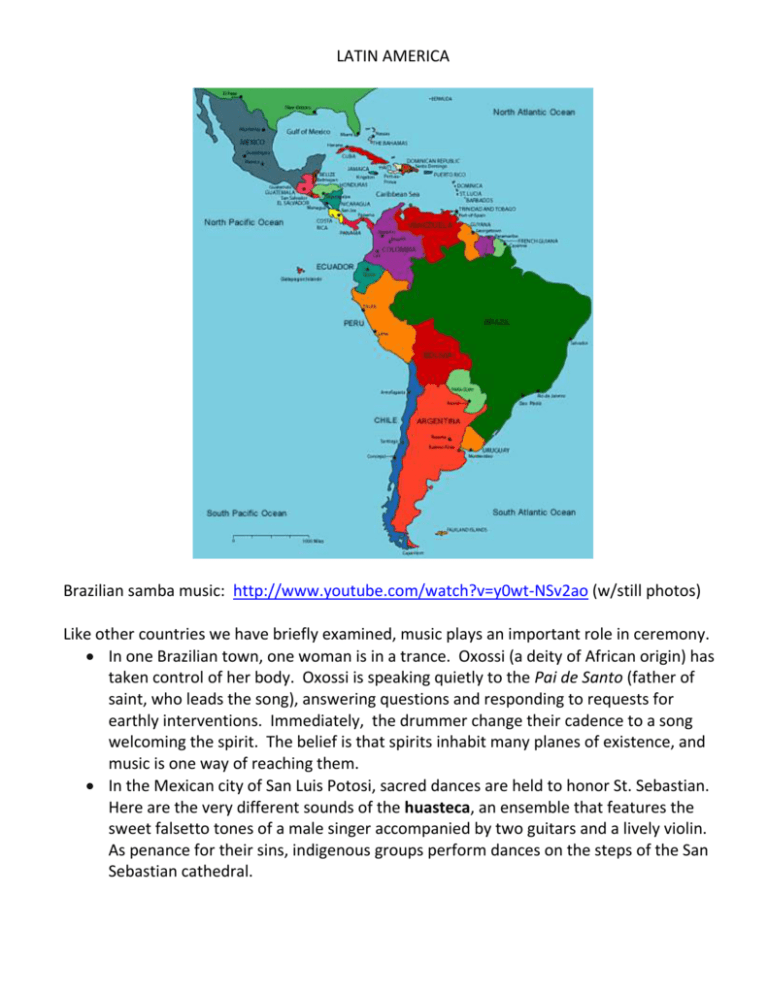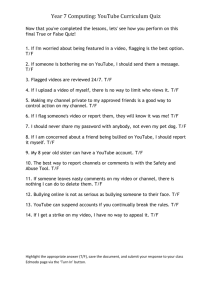Latin America
advertisement

LATIN AMERICA Brazilian samba music: http://www.youtube.com/watch?v=y0wt-NSv2ao (w/still photos) Like other countries we have briefly examined, music plays an important role in ceremony. In one Brazilian town, one woman is in a trance. Oxossi (a deity of African origin) has taken control of her body. Oxossi is speaking quietly to the Pai de Santo (father of saint, who leads the song), answering questions and responding to requests for earthly interventions. Immediately, the drummer change their cadence to a song welcoming the spirit. The belief is that spirits inhabit many planes of existence, and music is one way of reaching them. In the Mexican city of San Luis Potosi, sacred dances are held to honor St. Sebastian. Here are the very different sounds of the huasteca, an ensemble that features the sweet falsetto tones of a male singer accompanied by two guitars and a lively violin. As penance for their sins, indigenous groups perform dances on the steps of the San Sebastian cathedral. The above represents not only the diversity of Latin American music, but the rich artistic hybrids that result from syncretism—the fusion of cultures that takes place when different ethnic groups meet. The combining of traditions is evident in the conflation of Catholic saints with African deities; in the mixture of African, European, and indigenous musical instruments; and also the cultural attitudes that continue to drive artistic creativity in this huge region. ELEMENTS OF LATIN AMERICAN MUSIC Influences from European, African, and indigenous sources have shaped the characteristics of Latin American music. Use of harmony. Folk and popular music throughout Latin America adopted European harmonic techniques and harmonic progressions, often heard in the guitar strumming. Parallel thirds. Singers and instrumentalists thicken textures by adding a parallel melody the distance of a third. Paired phrases. Song texts are often written in paired lines, coplas, with pauses between lines. The first line of the pair ends with an unsettled feeling, which the second lines resolves. Distinctive dance rhythms. Characteristic rhythms often derived from the habanera and sesquialtera largely define Latin American dances. Rhythm guitar. Vigorous harmonic strumming of the guitars, as well as percussion, emphasize dance rhythms. LATIN AMERICAN DANCE RHYTHMS Dance Bambuco Country of Origin Colombia Bossa Nova Cueca Brazil Chile Cumbia Colombia Description Courtship dance associated with the highlands of Colombia http://www.youtube.com/watch?v=AfiMzpFuT28 Relaxed modern samba influenced by cool jazz Fast couple dance http://www.youtube.com/watch?v=uLFuMUfAu7k African-influenced fast duple meter dance http://www.youtube.com/watch?v=h5_2ZThUOUE Jarabe Mexico Joropo Venezuela Malambo Argentina Merengué Dom. Rep. Rumba Cuba Samba Brazil Tango Argentina Moderate dance http://www.youtube.com/watch?v=wtDNYqGNK3A Fast couples dance http://www.youtube.com/watch?v=hK59rQpXoxs Fast competition dance of gauchos (cowboys) http://www.youtube.com/watch?v=QihC4Opvfb4 Fast African-influenced dance with a distinctive simple duple rhythm http://www.youtube.com/watch?v=dPwIsTanhzs Highly syncopated simple duple rural dance http://www.youtube.com/watch?v=JO2Wk0r9wac Simple duple syncopated dance now known worldwide http://www.youtube.com/watch?v=Zj1fD18wPjM Slow urban couple dance with pronounced downbeats http://www.youtube.com/watch?v=1TyqjMp2HNI LATIN AMERICAN MUSICAL INSTRUMENTS Latin American instruments are often categorized according to their origins—indigenous, African or European. The European chordophone that has had the greatest influence is the guitar, which exists in innumerable forms, with 2 to 12 strings, ranging from very large bass instruments to small treble ones. European wind instruments are also common, including trumpets, clarinets, saxophones, accordions, etc. The marimba, originally from Africa, is common in music from southern Mexico and Central America. http://www.youtube.com/watch?v=eHNuuOblfc8 FOLK BANDS IN MEXICO Huapango. From the rural regions around Mexico City, this ensemble includes a mediumsized guitar (jarana) and a special large guitar (huapanguera). The violin plays fast-running figures. http://www.youtube.com/watch?v=6xswxrDzOqk&feature=PlayList&p=CEAD269AC10C531 3&playnext=1&playnext_from=PL&index=83 Mariachi. A costumed street-corner band. Includes a large guitar (guitarron), usually a pair of trumpets … more suitable for noisy urban settings, and sometimes violins. http://www.youtube.com/watch?v=gELfPvb06pE Jarocho. Music from the Veracruz region, known for lively dances. http://www.youtube.com/watch?v=SKwP3lIyMG0 (mini-documentary) MUSIC IN BRAZIL … Afro-Brazilian Heritage Batuque. Pairs take turns dancing, which often includes touching of the navels—a practice that scandalized church authorities—known as “semba” … probably the origin of “samba.” http://www.youtube.com/watch?v=z8APscqNy2I Maxixe. Highly syncopated Brazilian dance. http://www.youtube.com/watch?v=p3DHiGt67Kw Lundu. A popular Brazilian dance. http://www.youtube.com/watch?v=8XYaShTQn3U POPULAR MUSIC IN BRAZIL Composers Caetano Veloso and Gilberto Gil brought electric instruments and rock influence into the Brazilian mix. Caetano Veloso: http://www.youtube.com/watch?v=9754NizSyIA Gilberto Gil: http://www.youtube.com/watch?v=2ipd8TrBq3I MUSIC IN ANDEAN COUNTRIES ANDEAN INSTRUMENTS Kena. Notch flute. http://www.youtube.com/watch?v=FOZjfSm72dg Siku. Bamboo panpipes. http://www.youtube.com/watch?v=Qde2U7TvXzc Charango. A guitar-like lute with five double-strings. Traditionally, the body is made from an armadillo shell. Today the endangered armadillo is protected so they are often made from wood. http://www.youtube.com/watch?v=NEpjhp48AR4 Cajon. Open wooden box that a drummer sits on and plays. http://www.youtube.com/watch?v=jE_-9_JUFB0 HUAYNO—the most popular dance form throughout the Andes. Consists of a lively duple meter with a characteristic long-short rhythm. http://www.youtube.com/watch?v=Eez6T49YE0k




